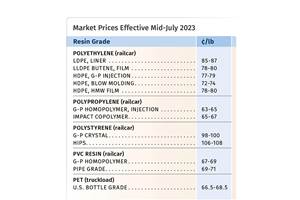Construction Awakens from Long Slumber
Wood on Plastics
Slowly but surely, the housing market is starting to perk up.
Break out the hats and horns. The long-awaited economic recovery is finally, really beginning. After five long years of declines, prices of U.S. homes have hit bottom and are now starting to rise. I expect this trend to continue regardless of who wins the election.
The accompanying chart shows recent activity in the national S&P/Case-Shiller Home Price Index. This index, designed to measure real estate prices in the U.S., is a quarterly average that is adjusted and weighted for things like seasonality and quality changes. It reveals that prices paid for homes stopped declining at the end of last year and have gradually increased so far in 2012.
The gains have been modest. The recovery is barely six months old, and we are starting this rebound from a very low baseline. We have a long way to go to get back to full health—at least two years. But barring any unforeseen shocks to the system, the market indicators for this sector will enter a sustained period of improvement.
This forecast is based on corroborating trends in other data that measure activity in residential construction and real estate. For the year to date, new housing starts are up more than 25% from the same period last year. New housing permits, a leading indicator of starts, are up 31% for the year. Total construction spending on residential projects, a number that includes renovations and remodeling as well as new construction, is up a whopping 18% for the year to date.
All this is driven by the recent gains in the residential real estate sector. The data on pending home sales, compiled and reported by the National Association of Realtors, is currently on an uptrend and in July it hit the highest level in more than two years. Historically low mortgage rates, an improving labor market, and rising buyer confidence are all supporting demand for homes. Not surprisingly, the trend in pending home sales is a leading indicator of the trend in the actual sales of existing-homes. So far this year, existing home sales are running 10% ahead of last year.
This is important because the residential construction and real estate sectors have led every economic recovery out of recession since World War II. Although the Great Recession officially ended more than three years ago, residential construction and real estate markets did not start to turn upward until recently. It is no coincidence that data measuring consumer confidence also stayed near the cyclical bottom during this time period. And once the rise in housing and real estate markets becomes more evident, confidence levels will surely follow.
Rising home prices generate increased economic activity in several ways. First, homeowners feel wealthier as their home equity values rise. They spend more on their homes, borrow more to finance other expenditures, and worry less about their mortgages.
Second, local banks are more willing and able to lend money when home prices rise. Houses will once again become a reliable source of collateral. Small-business owners, who frequently have to use their houses as collateral for their business loans, will have greater access to capital.
Third, local governments will again be able to rely on property tax revenues. This will curtail budget slashing, and allow municipalities to retain public workers. And finally, the construction trades are a significant generator of jobs in their own right.
WHAT THIS MEANS TO YOU
•Smart homes are the next big thing. Technology is rapidly creating ways to improve comfort, security, and energy efficiency in the home. Demand for these products will explode in the coming years.
•Homeowners in the Northeast will increasingly convert their homes to energy sources such as wind or natural gas, and away from coal and heating oil. This will change their buying patterns for many types of appliances and building materials.
•Home-generated energy sources (solar panels, geothermal wells, etc.) will enjoy an uptick in demand in the future. This will also affect the type of appliances and building materials consumed.
Related Content
Plastic Compounding Market to Outpace Metal & Alloy Market Growth
Study shows the plastic compounding process is being used to boost electrical properties and UV resistance while custom compounding is increasingly being used to achieve high-performance in plastic-based goods.
Read MoreChemical Recycling Process for Crosslinked PE
Borealis announces capability to produce recycled PE for use in wire & cable, infrastructure industries.
Read MorePS Prices Plunge, Others Appear to Be Bottoming Out
PS prices to see significant drop, with some potential for a modest downward path for others.
Read MoreArtificial Intelligence Enables Smarter Sourcing
Westfall Technik has adopted Arkestro’s predictive procurement software to wring savings and more reliable deliveries from a historically challenging supply chain.
Read MoreRead Next
Processor Turns to AI to Help Keep Machines Humming
At captive processor McConkey, a new generation of artificial intelligence models, highlighted by ChatGPT, is helping it wade through the shortage of skilled labor and keep its production lines churning out good parts.
Read MoreLead the Conversation, Change the Conversation
Coverage of single-use plastics can be both misleading and demoralizing. Here are 10 tips for changing the perception of the plastics industry at your company and in your community.
Read MoreWhy (and What) You Need to Dry
Other than polyolefins, almost every other polymer exhibits some level of polarity and therefore can absorb a certain amount of moisture from the atmosphere. Here’s a look at some of these materials, and what needs to be done to dry them.
Read More






















 (1).jpg;maxWidth=970;quality=90)